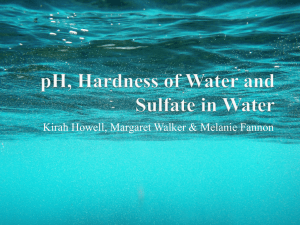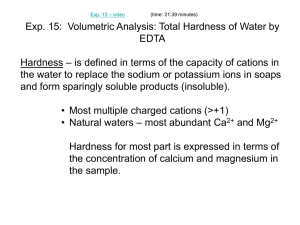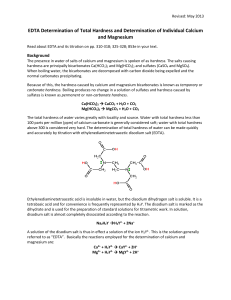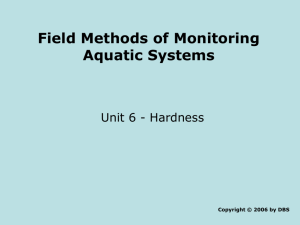Expt 28 Commentary
advertisement
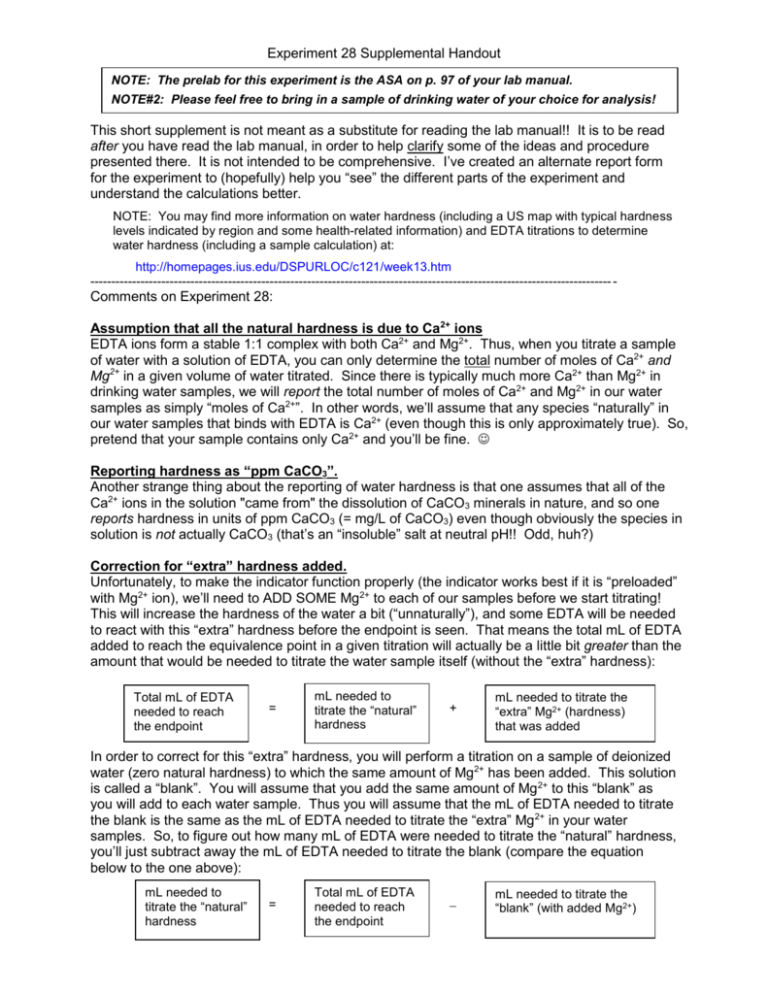
Experiment 28 Supplemental Handout NOTE: The prelab for this experiment is the ASA on p. 97 of your lab manual. NOTE#2: Please feel free to bring in a sample of drinking water of your choice for analysis! This short supplement is not meant as a substitute for reading the lab manual!! It is to be read after you have read the lab manual, in order to help clarify some of the ideas and procedure presented there. It is not intended to be comprehensive. I’ve created an alternate report form for the experiment to (hopefully) help you “see” the different parts of the experiment and understand the calculations better. NOTE: You may find more information on water hardness (including a US map with typical hardness levels indicated by region and some health-related information) and EDTA titrations to determine water hardness (including a sample calculation) at: http://homepages.ius.edu/DSPURLOC/c121/week13.htm ----------------------------------------------------------------------------------------------------------------------------- - Comments on Experiment 28: Assumption that all the natural hardness is due to Ca2+ ions EDTA ions form a stable 1:1 complex with both Ca2+ and Mg2+. Thus, when you titrate a sample of water with a solution of EDTA, you can only determine the total number of moles of Ca2+ and Mg2+ in a given volume of water titrated. Since there is typically much more Ca2+ than Mg2+ in drinking water samples, we will report the total number of moles of Ca2+ and Mg2+ in our water samples as simply “moles of Ca2+”. In other words, we’ll assume that any species “naturally” in our water samples that binds with EDTA is Ca2+ (even though this is only approximately true). So, pretend that your sample contains only Ca2+ and you’ll be fine. Reporting hardness as “ppm CaCO3”. Another strange thing about the reporting of water hardness is that one assumes that all of the Ca2+ ions in the solution "came from" the dissolution of CaCO3 minerals in nature, and so one reports hardness in units of ppm CaCO3 (= mg/L of CaCO3) even though obviously the species in solution is not actually CaCO3 (that’s an “insoluble” salt at neutral pH!! Odd, huh?) Correction for “extra” hardness added. Unfortunately, to make the indicator function properly (the indicator works best if it is “preloaded” with Mg2+ ion), we’ll need to ADD SOME Mg2+ to each of our samples before we start titrating! This will increase the hardness of the water a bit (“unnaturally”), and some EDTA will be needed to react with this “extra” hardness before the endpoint is seen. That means the total mL of EDTA added to reach the equivalence point in a given titration will actually be a little bit greater than the amount that would be needed to titrate the water sample itself (without the “extra” hardness): Total mL of EDTA needed to reach the endpoint = mL needed to titrate the “natural” hardness + mL needed to titrate the “extra” Mg2+ (hardness) that was added In order to correct for this “extra” hardness, you will perform a titration on a sample of deionized water (zero natural hardness) to which the same amount of Mg2+ has been added. This solution is called a “blank”. You will assume that you add the same amount of Mg2+ to this “blank” as you will add to each water sample. Thus you will assume that the mL of EDTA needed to titrate the blank is the same as the mL of EDTA needed to titrate the “extra” Mg 2+ in your water samples. So, to figure out how many mL of EDTA were needed to titrate the “natural” hardness, you’ll just subtract away the mL of EDTA needed to titrate the blank (compare the equation below to the one above): mL needed to titrate the “natural” hardness = Total mL of EDTA needed to reach the endpoint mL needed to titrate the “blank” (with added Mg2+)

